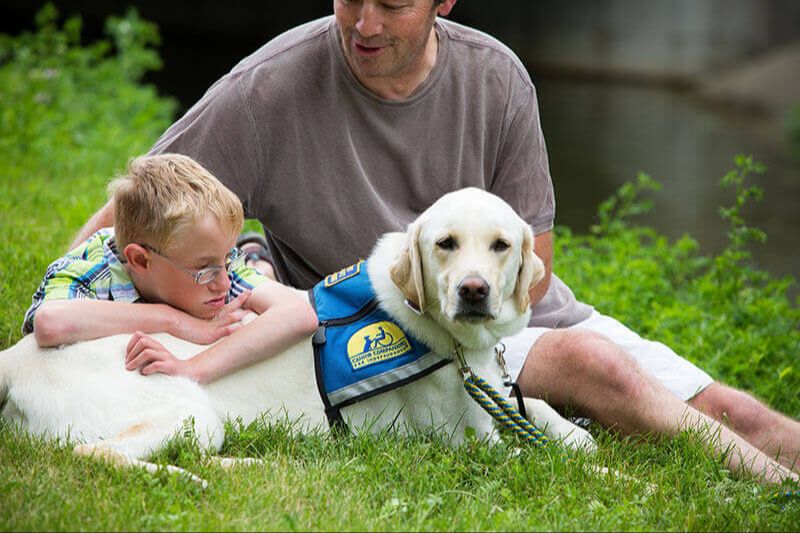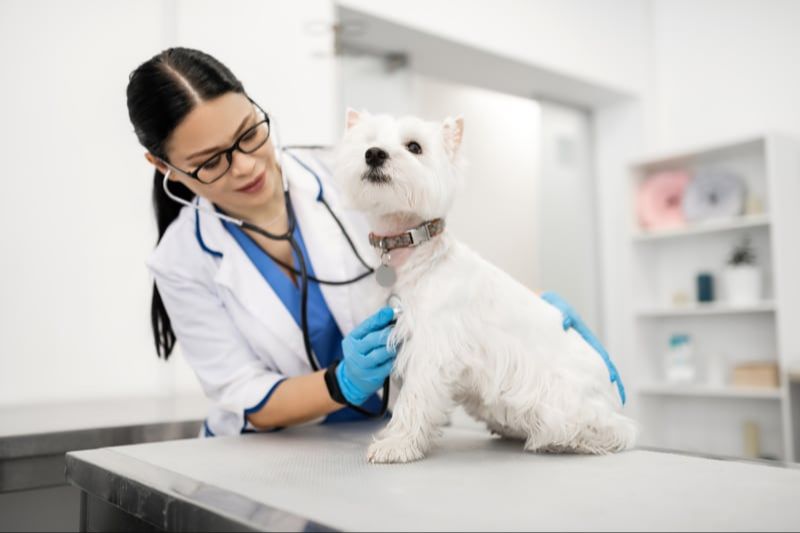Introduction
Autism is a developmental disorder characterized by challenges with social skills, repetitive behaviors, speech and nonverbal communication. It is considered a spectrum disorder because it affects individuals differently and with varying degrees of severity. In humans, autism is usually diagnosed in early childhood and the causes are not fully understood, although research suggests a genetic component.
There is growing evidence that dogs can also develop autism or autism-like symptoms. Canine autism, also referred to as canine dysfunctional behavior, shares many similarities with autism in humans. Affected dogs may have difficulty socializing, display repetitive or compulsive behaviors, be sensitive to sounds and touch, and have other developmental issues. While the causes in dogs are equally unclear, it is likely due to genetic and neurological factors. Understanding autism in both humans and dogs continues to be an active area of research.
What is Autism in Humans?
According to the Diagnostic and Statistical Manual of Mental Disorders (DSM-5) published by the American Psychiatric Association, autism spectrum disorder is characterized by persistent deficits in social communication and social interaction, along with restricted, repetitive patterns of behavior, interests or activities. Symptoms are present from early childhood and limit or impair everyday functioning.

The core symptoms of autism include:
- Deficits in social-emotional reciprocity like abnormal social approach or failure to engage in normal back and forth conversation.
- Deficits in nonverbal communication behaviors used for social interaction such as poorly integrated eye contact, posture, facial expressions, tone of voice and gestures.
- Deficits in developing and maintaining relationships appropriate to developmental level beyond those with caregivers.
- Stereotyped or repetitive speech, motor movements or use of objects.
- Excessive adherence to routines, ritualized patterns of behavior or excessive resistance to change.
- Restricted interests that are abnormal in intensity or focus.
- Hyper- or hyporeactivity to sensory input or unusual sensory interests.
For an autism diagnosis, symptoms must be present in early childhood, even if they are masked later on. Symptoms together limit and impair everyday functioning. The intensity of symptoms varies across individuals but all levels of severity cause significant impairment.
Detailed diagnostic criteria are provided in the DSM-5. Diagnosis is made by observing behavior and development to determine if milestones and communication abilities align with those expected for the age.
Can Dogs Have Autism?
There has been some debate in recent years over whether dogs can have autism or autism spectrum disorder. Some researchers believe dogs can exhibit symptoms similar to autism in humans, while others argue there is not yet definitive proof of autism in canines.
According to one study, some behaviors in dogs that parallel autism symptoms in humans include repetitive behaviors like chasing their own tail, lack of eye contact or response to social cues, sensitivity to loud noises and touch, and anxiety. Proponents argue these could be signs of autism, though there is no way to diagnose it definitively in dogs.
Critics contend there is no clear evidence that the same neurodevelopmental factors that cause autism in humans exist in dogs. They say symptoms that appear autism-like could be caused by other conditions like anxiety, obsessive compulsive disorder, or brain abnormalities. More research is needed to determine if autism itself occurs in canines.
Overall, the scientific community remains divided on whether true autism exists in dogs. There are documented cases of dogs exhibiting autistic-like behaviors, but no consensus that dogs can clinically have autism spectrum disorder akin to humans. Research is still in the early stages.
Autism-like Symptoms in Dogs
Some dogs can exhibit behaviors that resemble symptoms of autism in humans. While dogs can’t be definitively diagnosed with autism, the repetitive behaviors, social difficulties, and sensitivity to stimuli seen in autistic people are sometimes observed in canines as well.

Repetitive behaviors like excessive licking, tail chasing, pacing, and flank sucking may indicate a lack of social skills or discomfort, similar to the repetitive motions autistic people rely on to self-soothe. Dogs exhibiting these behaviors may have trouble interacting with other pets and struggle to pick up on social cues.
Socially, autistic-like dogs might be aloof, avoid eye contact, or not seek out petting or interaction. They may prefer isolation and not show interest in other dogs or their owners. Difficulty developing social skills can stem from inadequate exposure to various environments and stimuli during puppyhood.
Sensitivity to stimuli like loud noises, bright lights, and certain textures or smells can also cause anxiety in dogs prone to autistic tendencies. Reactions like cowering, agitation, and hiding may signal sensory overload. Dogs with high sensitivities have trouble acclimating to new experiences or environments.
While the causes behind autism in humans remain unclear, genetics and neurological wiring are contributing factors. The same may be true for canine behavior that mirrors autism symptoms. However, more research is still needed on the subject.
Sources:
https://luckytail.com/blogs/pet/can-dogs-have-autism
https://www.vetinfo.com/dog-autism-symptoms.html
Causes of Autism-like Behavior in Dogs
There are several potential causes for autism-like symptoms in dogs, similar to what is seen in human autism spectrum disorder.
Genetics may play a role, as certain breeds like German Shepherds seem more prone to displaying autism-like behaviors [1]. Researchers believe there may be inherited neurological differences that lead to the behavioral symptoms.
Environmental factors early in a dog’s development may also contribute. Exposure to certain toxins, poor nutrition, maternal stress, or lack of socialization as a puppy could impact normal brain development and function [2].
Additionally, structural differences in certain regions of the canine brain related to social cognition, sensory processing, and compulsions have been associated with dysfunctional behaviors reminiscent of autism [3].
Much like human autism, it is likely a combination of genetic, neurological, and environmental factors that lead to the development of autism-like symptoms in some dogs.
Getting a Diagnosis

Diagnosing autism in dogs can be challenging. Unlike in humans, there are no standard diagnostic criteria or tests for canine autism. Vets have to rely on observing symptoms and ruling out other conditions. According to one source, “Diagnosing autism in dogs involves a combination of differential diagnosis and veterinary assessment. This includes observing the dog’s behavior and administering tests to rule out other conditions with similar symptoms” (source).
Some of the challenges in diagnosing autism in dogs include:
- Lack of speech and communication – Dogs can’t describe their experiences verbally
- No standardized criteria – There are no official guidelines for canine autism diagnosis
- Overlap with other conditions – Symptoms may also indicate anxiety, OCD, trauma, etc.
- Individual variability – Symptoms can vary greatly between dogs
- Reliance on observation – Vets must make judgments based on observed behaviors
- No genetic or biomarker tests – Unlike human autism, canine autism has no definitive biological test
Getting an accurate autism diagnosis for a dog requires an experienced vet ruling out all other potential causes. It also requires long-term observation of the dog’s unique behaviors and symptoms. Even with extensive assessment, a definitive diagnosis may not be possible in all cases.
Living with an Autistic Dog
Living with an autistic dog can be challenging but rewarding. Here are some tips for training and managing symptoms:
Establish a routine – Dogs with autism thrive on routine. Set up a regular schedule for walks, play time, training, etc. Sticking to a routine helps reduce anxiety.
Use positive reinforcement – Reward desired behaviors with treats and praise. This is more effective for training than punishment.
Avoid sensory overload – Limit loud noises, bright lights, crowds, and other stimuli that may be overstimulating. Create a quiet space the dog can retreat to.
Teach response cues – Use cues like “look” or hand targets to refocus the dog’s attention. This provides a way to interrupt repetitive behaviors.
Consider medication – In some cases, anxiety medication prescribed by a vet can help manage extreme symptoms. This may make training easier.
Be patient – Progress will come slowly. Celebrate small victories. With time and consistency, an autistic dog can thrive.
Consult trainers – Professional trainers experienced with special needs dogs can provide customized training plans.
Adjust your expectations – Accept the dog for who they are. Their limitations are part of what makes them unique.
Provide plenty of exercise – Regular exercise helps relieve stress and excess energy.
Maintain a safe environment – Ensure the dog can’t access dangerous items. Use baby gates, crates, etc. to remove temptations.
Give them a job – Assigning a “job” like retrieving items or responding to commands gives purpose and focus.
Treatment Options
There are several treatment options that can help dogs exhibiting autism-like symptoms and behaviors live happier, more comfortable lives. Some of the main treatment approaches include:

Medication – While there are no medications specifically designed to treat autism in dogs, vets may prescribe medicines to help manage related symptoms like anxiety, obsessive behaviors, and sensory sensitivity. Commonly prescribed medications include fluoxetine, clomipramine, and benzodiazepines. However, medication effects can vary greatly between individual dogs.
Training – Behavioral training is tailored to each dog’s specific needs. It aims to teach autistic dogs skills to better cope with daily life and build confidence. Training often focuses on socialization, communication, reducing anxiety triggers, and rewarding calm behavior. A positive reinforcement approach is recommended.
Environmental Changes – Adjusting aspects of a dog’s environment can help minimize stress triggers. Examples include establishing a predictable routine, providing a quiet sheltered space to retreat to, using pheromone diffusers, playing calming music, and limiting exposure to noises or situations that cause sensory overload.
The Outlook for Autistic Dogs
The prognosis for dogs with autism can vary depending on the severity of symptoms. With early intervention and consistent training, some dogs are able to improve their social skills and quality of life. However, autism is a lifelong condition and most dogs will continue to show some deficits throughout their lives.
According to one study, the average life expectancy for autistic dogs was about 7 years (https://www.discovermagazine.com/lifestyle/can-dogs-have-autism-full-guide-and-breakdown). However, with proper care and management of symptoms, many dogs can live happy and fulfilling lives into their senior years. The key is providing structure, routine and compassionate training suited to the individual dog’s needs.
While there is no cure for canine autism, treatment focuses on managing symptoms and teaching dogs coping skills. With dedication from owners, autistic dogs can learn to better handle stimuli, improve social interactions, reduce anxiety and build confidence. Continued behavior modification therapy and training is essential even after initial progress.
The outlook for each autistic dog depends on their unique challenges. But with patience and the right support, families can have hope that their furry companions can live improved lives. By understanding their needs and limitations, owners can continue to provide the special care required for dogs with autism to thrive.
Conclusion
In summary, while dogs cannot be diagnosed with autism in the clinical sense, some dogs can exhibit symptoms that resemble autism in humans. These autism-like behaviors, such as repetitive actions, sensitivity to stimuli, and unresponsiveness, likely stem from a combination of genetic and environmental factors. Though challenging, living with an autistic dog is possible with proper training, socialization, medical treatment, and environmental management. With patience and compassion, families can find ways to enrich their autistic dog’s life and form a meaningful bond.
More research is needed to understand the neurological basis of autism-like symptoms in dogs. By studying dogs that exhibit autistic tendencies, scientists may gain new insights into autism in humans as well. With further study, we can continue developing more targeted treatments to help both dogs and people cope with autism spectrum disorders. Though our understanding is limited, there is hope that greater knowledge and awareness will improve the lives of autistic individuals, both human and canine.